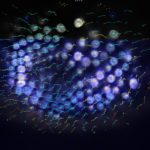Link to Pubmed [PMID] – 41240339
Link to DOI – 10.1016/j.celrep.2025.116541
Cell Rep 2025 Nov; 44(11): 116541
Here, we uncover that neutrophils release a fibrillar complex, named proteoglycofili (PGF), under hypoxic conditions or upon bacterial infection, using Shigella as a model. PGF are preferentially released by neutrophils over neutrophil extracellular traps upon bacterial infection. PGF are released by living neutrophils, do not contain DNA, are mainly composed of granule proteins, and contain cytokines. We reveal that the fibrillar structure of PGF is sustained by two glycosaminoglycans (GAGs), hyaluronic acid, and chondroitin sulfate, released by neutrophils. We demonstrate that PGF are potent antimicrobials, which degrade virulence factors of Shigella and block its growth, similar to E. coli or Salmonella. GAGs are essential for PGF antimicrobial activity both in vitro and in vivo. Beyond bacterial infections, and reported in a mouse model of colon cancer, our results strongly suggest that GAGs may be released by neutrophils in a broad range of inflammatory diseases.




